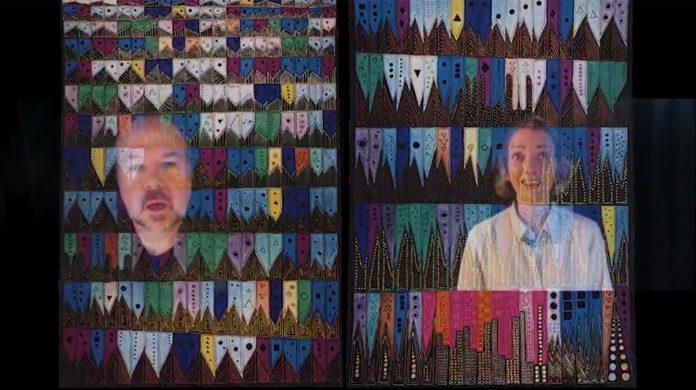
No doubt fans of figure skating or ice dancing are very familiar with Maurice Ravel’s classical music masterpiece “Bolero.” Perhaps the most memorable occurred in February 1984 when Torvill and Dean’s iconic performance to Ravel’s classic masterpiece won them the gold medal, and earned them 12 perfect 6.0 scores from the judges during the Winter Olympics in Sarajevo. But other than his music, what do you really know about the French composer’s life?
My curiosity led me to watch Los Angeles-based playwright Jake Broder’s new drama ‘UnRavelled,’ in which art, music and science intersect. Based on true events and incorporating research and interviews conducted by Broder as a Hellman Visiting Artist at UCSF’s Memory and Aging Center, the play explores the fascinating connection between the work of Canadian painter Anne Adams (1940–2007) and French composer Maurice Ravel (1875–1937), both of whom lived with the same rare brain disease.
According to Memory and Aging Center director and Global Brain Health Institute co-director Dr. Bruce Miller, “Ravel and Dr. Adams were in the early stages of primary progressive aphasia, a form of frontotemporal dementia, when they were working. The disease apparently altered circuits in their brains, changing the connections between the front and back parts and resulting in a torrent of creativity.”
Perhaps that is why Ravel’s repetitive patterns that cycle through “Bolero” drew Adams to artistically express how the music spoke to her creative soul. Director Nike Doukas shares, “The science is fascinating – the idea that this rare form of dementia allowed Anne to experience music so vividly that she felt compelled to begin painting pictures of her auditory experience. But the real themes of the play revolve around identity and love. The beauty of the writing, the humanism paired with science, and the wonderful cast are what make this project so compelling.”
Featured in the cast is Lucy Davenport as Adams, a renowned scientist, who, in her fifties and at the height of her career, lost interest in science and began painting. Starting out with simple works, Adams became suddenly, inexplicably obsessed by Ravel’s famous symphonic masterpiece and began to paint in a wildly different style. The result was Adams’ most famous work, “Unravelling Boléro,” a virtuosic painting of brilliant design and color, in which she transcribed Ravel’s music bar by bar.
Award-winning actor Rob Nagle portrays Anne’s husband, Robert, who, in his attempt to understand and navigate Anne’s radically changing sense of self, eventually brought her to see Dr. Miller, portrayed in the play by Obie award-winning actor Leo Marks. Conor Duffy plays Ravel, whose one-movement orchestral piece, composed as a ballet for Russian dancer Ida Rubinstein, became his most famous work, in spite of the fact that it, too, was a radical departure in style for the composer. Rounding out the cast is Michael Lanahan who provides the ongoing narration.
We first meet Robert and Anne during an intense Scrabble match, then follow the couple through her decision to stick with painting after nursing their son back to health after his car accident crisis has passed. Nagle and Davenport take us into the lives of the married couple as their marriage begins to suffer as Anne withdraws into her studio to create art as her words begin to fail along with her memory. Between each scene, Dr. Marks shares via a lecture to his students about the progression of Anne’s symptoms, which are then brilliantly portrayed by Davenport, showing us how Anne now sees Ravel’s music, as well as most of the world, in squares of different colors that speak to her soul.
Along with these scenes, we watch as Ravel also begins to suffer similar frailties, such as short-term memory loss, during the creation of “Bolero.” Thus, it is vividly evident that the two artists from different eras, while celebrating their bursts of creatively, were doomed to suffer the same debilitating behavioral consequences. I found myself totally pulled into the characters and their stories, gaining new insight into both his music and her art. Now I need to really listen to “Bolero” in the presence of her canvas to appreciate how each square perfectly reflects the spirit and tone of his beautifully repetitive, iconic piece.
The virtual presentation of ‘UnRavelled,’ sponsored by the Global Brain Health Institute, based at the University of California, San Francisco; and Trinity College Dublin, the University of Dublin, Ireland, directed by Nike Doukas, began on Feb. 25 and continues streaming free and on demand though March 31.To register to receive a free link to view the play and to learn more about the supporting live events, go to www.UnRavelledPlay.com.













